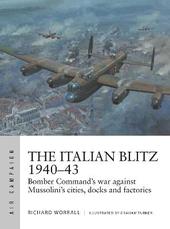
|
The Italian Blitz 1940-43: Bomber Command's war against Mussolini's cities, docks and factories
Paperback / softback
Main Details
| Title |
The Italian Blitz 1940-43: Bomber Command's war against Mussolini's cities, docks and factories
|
| Authors and Contributors |
By (author) Richard Worrall
|
|
Illustrated by Graham Turner
|
| Series | Air Campaign |
|---|
| Physical Properties |
| Format:Paperback / softback | | Pages:96 | | Dimensions(mm): Height 248,Width 184 |
|
| Category/Genre | Military history
Second world war |
|---|
| ISBN/Barcode |
9781472841452
|
| Classifications | Dewey:940.54215 |
|---|
| Audience | | General | | Professional & Vocational | |
|---|
| Illustrations |
Illustrated throughout with around 60 photos and at least 14pp of colour illustrations
|
|
Publishing Details |
| Publisher |
Bloomsbury Publishing PLC
|
| Imprint |
Osprey Publishing
|
| NZ Release Date |
18 August 2020 |
| Publication Country |
United Kingdom
|
Description
Between June 1940 and August 1943, RAF Bomber Command undertook a little-known strategic bombing campaign in Europe. The target was Mussolini's Italy. This air campaign was a key part of the strategic policy of Britain from 1940 to 1943, which aimed at securing Italy's early surrender. However, it posed unique challenges, not least of which was Italy's natural defences of distance and the Alps. The bombing campaign against Italy can be divided into a number of phases, with each one having its own specific goals such as affecting Italian war production or hindering the Italian Navy's war in the Mediterranean. However, each also furthered the ultimate aim of forcing Italy's final capitulation, demonstrating that the tactic of area-bombing was not just about the destruction of an enemy's cities, as it could also fulfil wider strategic and political objectives. Indeed, the intensity and frequency of attack was greatly controlled, and the heavy bombing of Italy was only ever sanctioned by Britain's civilian war leaders to achieve both military and political goals. The issue of target-selection was also subject to a similar political restriction; cities and ports like Milan, Turin, Genoa and La Spezia were sanctioned under an official Directive, but other places, such as Verona, Venice, Florence and, above all, Rome, remained off-limits. This fascinating title from British strategic and military history expert Dr Richard Worrall explores the political, motivational and strategic challenges of the campaign in full. His thorough analysis and meticulous research is supported by specially commissioned artwork, maps, and contemporary photographs.
Author Biography
Dr Richard Worrall teaches at the Department of History, Politics & Philosophy at Manchester Metropolitan University, and has taught history for over ten years, most recently in Singapore, and previously at the London School of Economics and Manchester Metropolitan University. His PhD from the University of Oxford focused on British strategic and military history, and he also holds an MA in Imperial and Commonwealth History from King's College London, and a BSc in International History from the LSE. Graham Turner is a leading historical artist, specializing in the medieval period. He has illustrated numerous titles for Osprey, covering a wide variety of subjects from the dress of the 10th-century armies of the Caliphates, through the action of bloody medieval battles, to the daily life of the British Redcoat of the late 18th century. The son of the illustrator Michael Turner, Graham lives and works in Buckinghamshire, UK.
ReviewsThis book fills a gap in the historical coverage of World War II in the air and should be acquired by anyone who wants a complete record of the aerial campaigns. I found it a fascinating read, and will always treasure my copy. I would certainly highly recommend it to anyone interested in the history of World War II in the air. Don't miss out on this one. - IPMS USA Reviews
|